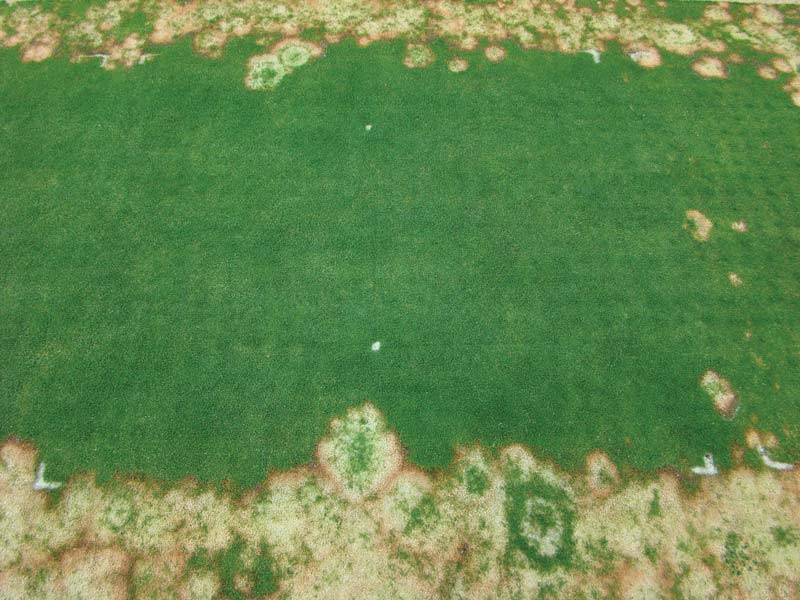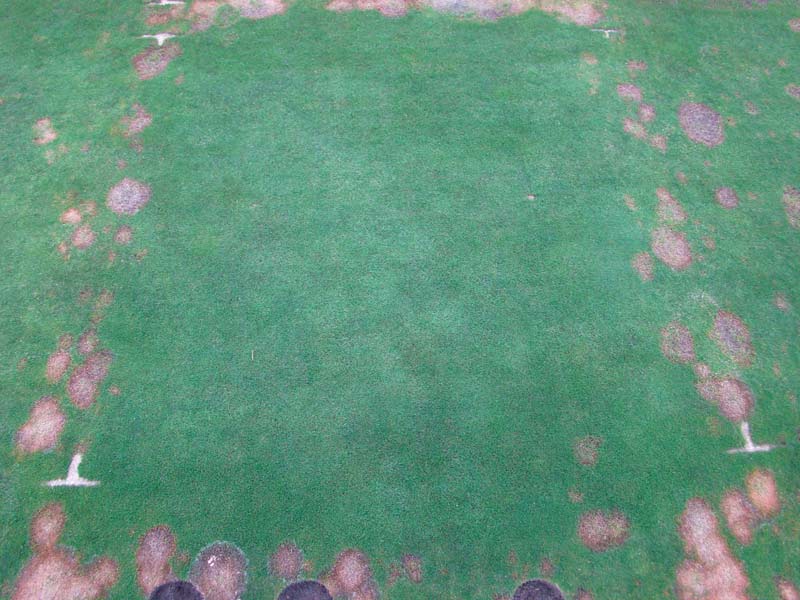Controlling Microdochium patch is a major concern for superintendents in the Pacific Northwest who manage annual bluegrass (Poa annua) putting greens. Restrictions in certain regions limiting pesticide use have created a quandary for superintendents attempting to maintain desirable playing conditions.
For several years, researchers at Oregon State University in Corvallis, Ore., have been conducting research to develop alternatives to traditional fungicides. This research is part of that continuing effort.
Experiment 1: Civitas Turf Defense and phosphorous acid + sulfur and phosphorous acid
The first trial incorporated the use of Civitas Turf Defense (a horticulture oil, Intelligro) and a phosphorous acid in a seasonal rotation with sulfur and a phosphorous acid. This trial also included a timing component that quantified the effects of a two-week application interval compared with a three-week application interval.
The two-year field trial began Sept. 29, 2016, and final data collection for the first year was April 30, 2017. The second-year trial replication began Sept. 28, 2017, on a new area of the same green, and concluded April 30, 2018. This trial was subjected to replicated golfer traffic (76 golf rounds a day) to mimic real-world conditions and allow for a better assessment of the impact of the treatments on turfgrass recovery from traffic and on overall turfgrass quality.


Figure 1. Top: A non-treated plot on an annual bluegrass putting green in Corvallis, Ore. Bottom: A plot on the same green showing the effects of treatment with 8.5 fluid ounces Civitas Turf Defense/1,000 square feet (27 liters/hectare) + 3.2 fluid ounces DuraPhite 12/1,000 square feet every two weeks in October and November 2017 and April 2018, and 0.25 pound sulfur + 3.2 fluid ounces DuraPhite 12/1,000 square feet every two weeks from December 2017 through March 2018. Both photos were taken on Feb. 1, 2018. Photos by Clint Mattox
Preliminary observations for both years suggest that more frequent applications (every two weeks compared with every three weeks) will provide a greater expectation of disease inhibition (Figure 1). Some abiotic damage has been observed in the coldest parts of the winter on plots that received Civitas Turf Defense when annual bluegrass was not actively growing. As a result, the highest turfgrass quality ratings were given to treatments that avoided applications entirely or reduced application frequency of the horticulture oil in the winter months.
Experiment 2: Iron sulfate rates and phosphorous acid
The second trial explored different rates of iron sulfate (FeSO4) in combination with a phosphorous acid on a two-week application interval.
This two-year field trial began Sept. 29, 2016, and final data collection for year 1 was taken April 30, 2017. The second-year trial replication began Sept. 28, 2017, on a new area of the same green and concluded April 30, 2018. This trial was subjected to replicated golfer traffic (76 golf rounds a day) that mimicked real-world conditions and allowed for a better assessment of the impact of the treatments on turfgrass recovery from traffic and on overall turfgrass quality.


Figure 2. Top: A non-treated plot on an annual bluegrass putting green in Corvallis, Ore. Bottom: A plot on the same green showing the effects of treatment with 0.5 pound FeSO4/1,000 square feet (24.4 kilograms/hectare) + 3.2 fluid ounces DuraPhite 12/1,000 square feet every two weeks from October 2017 through April 2018. Both photos were taken on Feb. 1, 2018. Photos by Clint Mattox
The first- and second-year observations support earlier evidence that, as rates of iron sulfate increase, the inhibition of Microdochium patch also tends to increase (Figure 2). Higher rates of iron sulfate also tend to lead to greater turfgrass thinning and lower turfgrass quality ratings (especially at the highest rate of 2.0 pounds FeSO4/1,000 square feet [97.6 kilograms/hectare] every two weeks).
Both years of preliminary data suggest that the addition of phosphorous acid with lower rates of iron sulfate will result in similar disease suppression observed at higher rates of iron sulfate while lessening the effects of turfgrass thinning and blackening of the turfgrass canopy caused by the higher iron sulfate treatments.
Experiment 3: Nitrogen, phosphorus and potassium rates applied fall through spring
Research on primary nutrient nitrogen, phosphorus and potassium ratios has suggested that maintaining the proper balance of the nutrients is critical to disease mitigation. However, research on nitrogen, phosphorus and potassium ratios relevant to annual bluegrass and Microdochium patch is not available.
Contrary to traditional recommendations, recent research has suggested that nitrogen applications applied fall through spring can improve annual bluegrass playing conditions and disease resistance. However, Microdochium patch will increase if nitrogen rates are too high. The objective of this research is to evaluate the effects of nitrogen, phosphorus and potassium rates applied fall through spring on Microdochium patch development within an annual bluegrass putting green in the absence of traditional fungicides.
Field research was initiated in September 2018 on a sand-based putting green constructed in 2009 at the Lewis-Brown Horticulture Farm, Corvallis, Ore. Experimental design is a 2 × 2 × 2 factorial randomized complete block design with four replications. Factors include nitrogen, phosphorus and potassium rates.
All of these treatments receive monthly applications of phosphorous acid (DuraPhite 12 [Simplot], applied at 3.2 fluid ounces/1,000 square feet [10.2 liters/hectare]) and sulfur (Sulfur-DF [Wilbur-Ellis], applied at 0.25 pound elemental sulfur/1,000 square feet [12.2 kilograms/hectare]), both of which are fungicide alternatives that have shown promising results for control of Microdochium patch. Traditional fungicides will not be applied to this experiment for the duration of the study, except for summer anthracnose control.
Preliminary observations showed that monthly applications of high rates of nitrogen (0.2 pound/1,000 square feet [9.8 kilograms/hectare]) in fall through spring resulted in the highest percent disease, while low rates (0.10 pound/1,000 square feet [4.9 kilograms/hectare]) resulted in the lowest percent disease. Potassium applied at 0.10 pound/1,000 square feet reduced percent disease when compared with treatments that did not receive potassium. The effect of phosphorus rate and the interactions among nitrogen, phosphorus and potassium were not significant.
Findings suggest that applications of nitrogen and potassium in fall through spring at 0.10 pound/1,000 square feet each can mitigate Microdochium patch activity (Table 1).
Clint Mattox is a graduate student, Alec Kowalewski is an associate professor, and Brian McDonald is a senior faculty research assistant in the Department of Horticulture at Oregon State University, Corvallis, Ore.